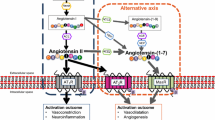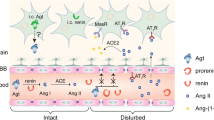Abstract
The hypothesis that angiotensin II (Ang II) might have a stroke-protective role was first proposed by Brown and Brown about 25 years ago. Their hypothesis was generated from the results of the first Medical Research Council trial in patients with mild to moderate hypertension, which showed that patients treated with the diuretic bendrofluazide had a 70% decrease in strokes compared with those treated with the β-blocker propranolol for similar blood pressure reduction. This hypothesis, which remained dormant for many years, was recently resurrected by several experimental studies that showed that the brain possesses its own renin-angiotensin system (RAS) similar to the one existing in the systemic circulation. These studies also showed that the brain RAS plays an important role in stroke prevention and neuronal protection through its active peptide Ang II. In addition, these studies demonstrated that the beneficial effects of Ang II are mediated through stimulation of its subtype 2 receptors, and possibly through stimulation of the subtype 4 receptors by Ang IV, a metabolite of Ang II. Drugs that selectively block the Ang II subtype 1 receptors, such as the angiotensin receptor blockers, have shown superior protection against strokes and neuronal damage than drugs that decrease the generation of Ang II, such as the angiotensin-converting enzyme inhibitors and β-blockers. In this review, the role of the Ang II receptors and their mechanism of action regarding stroke prevention are discussed in view of the evidence from experimental and clinical studies.

Similar content being viewed by others
References
Brown MJ, Brown J. Does angiotensin II protect against strokes? Lancet. 1986;2:427–9.
The Medical Research Working Party. The MRC trial of treatment of mild hypertension: principal results. BMJ. 1985;291:97–104.
Chrysant SG. The pathophysiologic role of the brain renin-angiotensin system in stroke protection: clinical implications. J Clin Hypertens. 2007;9:454–9.
Faure S, Bureau A, Oudart N, et al. Protective effect of candesartan in experimental ischemic stroke in the rat mediated by AT2 and AT4 receptors. J Hypertens. 2008;26:2008–15.
Fisher-Ferraro C, Nahmod VE, Goldstein DJ, Finkielman S. Angiotensin and rennin in the rat and dog brains. J Exp Med. 1971;133:353–61.
Unger T, Badoer E, Ganten D, Lang RE, Retig R. Brain angiotensin: pathways and pharmacology. Circulation. 1988;77(Part 2):140–54.
Mergenthaler P, Dimagl U, Meisel A. Pathophysiology of stroke: lessons from animal models. Metab Brain Dis. 2004;19:151–67.
Astrup J, Siesjo BK, Symon L. Threshold in cerebral ischemia-the ischemic penumbra. Stroke. 1981;12:723–7.
Ginsberg MD. Adventures in the pathophysiology of brain ischemia: penumbra, gene expression, neuroprotection. The 2002 Thomas Willis lecture. Stroke. 2003;34:214–23.
Wilms H, Rosenstiel P, Deusscl G, Lucius R. Neuroprotection with angiotensin receptor antagonists: a review of the evidence and potential mechanisms. Am J Cardiovasc Drugs. 2005;5:245–53.
Chrysant SG. Vascular remodeling: the role of angiotensin converting enzyme inhibitors. Am Heart J. 1998;135:S21–30.
Vacher E, Richer C, Giudicelli JF. Effects of losartan on cerebral arteries in stroke-prone spontaneously hypertensive rats. J Hypertens. 1996;14:1341–8.
Dai WJ, Funk A, Herdegen T, Unger T, Culman J. Blockade of central angiotensin AT (1) receptors improves neurological outcome and reduces expression of AP-1 transcription factors after focal brain ischemia in rats. Stroke. 1999;30:2391–8.
Engelhorn T, Goerike S, Doefler A, et al. The angiotensin II type 1 receptor blocker candesartan increases cerebral blood flow, reduces infarct size, and improves neurologic outcome after transient cerebral ischemia in rats. J Cerebral Blood Flow Metab. 2004;24:467–74.
Brdon J, Kaiser S, Hageman F, et al. Comparison between early and delayed systemic treatment with candesartan of rats after ischemic stroke. J Hypertens. 2007;25:187–98.
Allen AM, Zhuo J, Mendelsohn FA. Localization of angiotensin AT1 and AT2 receptors. J Am Soc Nephrol. 1999;10:S23–9.
Millan MA, Jacobowitz DM, Aguillera C, Catt KJ. Differential distribution of AT1 and AT2 angiotensin II receptor subtypes in the rat brain during development. Proc Natl Acad Sci USA. 1991;88:11440–4.
Steckelings UM, Kaschina E, Unger T. The AT2 receptor—a matter of love and hate. Peptides. 2005;26:1401–9.
Thone-Reineke C, Steckelings UM, Unger T. Angiotensin receptor blockers and cerebral protection in stroke. J Hypertens. 2006;24:S115–21.
Li J, Culman J, Hortnagl H, et al. Angiotensin AT2 receptor protects against cerebral ischemia-induced neuronal injury. FASEB J. 2005;19:617–9.
Wright JW, Harding JW. Brain angiotensin receptor subtypes in the control of physiological and behavioral responses. Neurosci Biobehav Rev. 1994;18:21–53.
Braszko J. The combination of the AT1 and AT2 angiotensin receptors to its cognitive effects. Acta Neurobiol Exp. 1996;56:49–54.
Iwai M, Liu HW, Chen R, et al. Possible inhibition of focal cerebral ischemia by angiotensin II type 2 receptor stimulation. Circulation. 2004;110:843–8.
Harding JW, Wright JW, Swanson GN, et al. AT4 receptors: specificity and distribution. Kidney Intern. 1994;46:1510–2.
DeGasparo M, Catt KJ, Inagami T, et al. International union of pharmacology XXIII. The angiotensin II receptors. Pharmacol Rev. 2000;52:415–72.
Wright JW, Harding JW. The angiotensin AT4 receptor subtype as a target for the treatment of memory dysfunction associated with Alzheimer’s disease. J Renin Angiotensin Aldosterone Syst. 2008;9:226–37.
Coleman JK, Krebs LT, Hamilton TA, et al. Autoradiographic identification of kidney angiotensin IV binding sites and angiotensin IV –induced renal cortical blood flow changes in rats. Peptides. 1998;19:269–77.
Hamilton TA, Handa RK, Harding JW, Wright JW. A role for the angiotensin IV/AT4 system in mediating natriuresis in the rat. Peptides. 2001;22:935–44.
Kramar EA, Harding JW, Wright JW. Angiotensin II-and IV-induced changes in cerebral blood flow. Roles of AT1, AT2, and AT4 receptor subtypes. Regul Pept. 1997;68:131–8.
Stragier B, Debundel D, Sarre S, et al. Involvement of insulin-regulated aminopeptidase in the effects of the renin-angiotensin fragment angiotensin IV: a review. Heart Fail Rev. 2008;13:321–37.
Fernandez LA, Caride VJ, Stromberg C, et al. Angiotensin AT2 receptor stimulation increases survival in gerbils with abrupt unilateral carotid ligation. J Cardiovasc Pharmacol. 1994;24:937–40.
Dalmay F, Mazouz H, Allard J, et al. Non- AT (1)- receptor mediated protective effect of angiotensin against acute ischemic stroke in the gerbil. J Renin Angiotensin Aldosterone Syst. 2001;2:103–6.
Kozak W, Kozak A, Johnson MH, Elewa HF, Fagan SC. Vascular protection with candesartan after experimental acute stroke in hypertensive rats: a dose-response study. J Pharmacol Exp Ther. 2008;326:773–82.
Dahlof B, Devereaux RB, Kjeldsen SE, et al. Cardiovascular morbidity and mortality in Losartan For Endpoint reduction (LIFE) in hypertension: a randomized trial against atenolol. Lancet. 2002;359:995–1003.
Kjeldsen SE, Dahlof B, Devereaux RB, et al. Effects of losartan on cardiovascular morbidity and mortality in patients with isolated systolic hypertension and left ventricular hypertrophy: a Losartan Intervention For Endpoint reduction (LIFE) substudy. JAMA. 2002;288:1491–8.
Lithell H, Hanson L, Skoog I, et al. The Study on Cognition and Prognosis in the Elderly (SCOPE): principal results of a randomized double-blind intervention trial. J Hypertens. 2003;21:875–86.
Papademetriou V, Farsang C, Elmfeld D, et al. Stroke prevention with the angiotensin II type 1 receptor blocker candesartan in elderly patients with isolated systolic hypertension: the Study on Cognition and Prognosis in the Elderly (SCOPE). J Am Coll Cardiol. 2004;44:1175–80.
Schrader J, Luders S, Kulshewski A, et al. The ACCESS study: evaluation of Acute Candesartan Cilexetil Therapy in Stroke Survivors. Stroke. 2003;34:1699–703.
Schrader J, Luders S, Kulshewski A, et al. Morbidity and mortality after stroke, eprosartan compared with nitrendipine for secondary prevention: principal results of a randomized controlled study (MOSES). Stroke. 2005;36:1218–26.
Julius S, Kjeldsen SE, Weber M, et al. Outcomes in hypertensive patients at high cardiovascular risk treated with a regimens based on valsartan or amlodipine: the VALUE randomized trial. Lancet. 2004;363:2022–31.
Yusuf S, Koon KT, Pogue J, et al. Telmisartan, ramipril, or both in patients at high risk for vascular events. The ONTARGET Investigators. N Engl J Med. 2008;358:1547–59.
Yusuf S, Teo K, Anderson C, et al. Effects of the angiotensin-receptor blocker telmisartan on cardiovascular events in high risk patients intolerant to angiotensin-converting enzyme inhibitors: a randomized controlled trial. The Telmisartan Randomised Assessment Study in ACE iN tolerant Subjects with Cardiovascular Disease (TRANSCEND) Investigators. Lancet. 2008;372:1174–83.
Yusuf S, Diener HC, Sacco RL, et al. Telmisartan to prevent recurrent stroke and cardiovascular events. For the PRoFESS Study Group. N Engl J Med. 2008;359:1225–37.
Sandset EC, Barth PM, Boysen G, et al. The angiotensin-receptor blocker candesartan for treatment of acute stroke (SCAST): a randomized, placebo-controlled, double-blind trial. Lancet. 2011;377:741–50.
Chrysant SG. Possible pathophysiologic mechanisms supporting the superior stroke protection of angiotensin receptor blockers compared to angiotensin-converting enzyme inhibitors: clinical and experimental evidence. J Hum Hypertens. 2005;19:923–31.
Roger VL, Go AS, Lloyd-Jones DM, et al. Heart disease and stroke statistics-2011 update. A report from the American Heart Association. Circulation. 2011;123:e18–e209.
Turnbull F, Neal B, Algert C, et al. Blood Pressure Lowering Treatment Trialists’ Collaboration. Effects of different blood pressure-lowering regimens on major cardiovascular events in individuals with and without diabetes mellitus: results of prospectively designed overviews of randomized trials. Arch Intern Med. 2005;165:1410–9.
Turnbull F, Neal B, Ninomiya T, et al. Blood Pressure Lowering Treatment Trialists’ Collaboration. Effects of different regimens to lower blood pressure on major cardiovascular events in older and younger adults: meta-analysis of randomized trials. BMJ. 2008;336:1121–7.
Czernichow S, Zanchetti A, Turnbull F, et al. Blood Pressure Lowering Treatment trialists’ Collaboration. The effects of blood pressure reduction and different blood pressure-lowering regimens on major cardiovascular events according to baseline blood pressure: meta-analysis of randomized trials. J Hypertens. 2011;29:4–16.
Turnbull F. Blood Pressure Lowering Treatment Trialists’ Collaboration. Effects of different blood-pressure-lowering regimens on major cardiovascular events: results of prospectively-designed overviews of randomized trials. Lancet. 2003;362:1527–35.
Turnbull F, Neal B, Pfeffer M, et al. Blood Pressure Treatment Trialists’ Collaboration. Blood pressure-dependent and independent effects of agents that inhibit the renin-angiotensin system. J Hypertens. 2007;25:951–8.
Law MR, Morris JK, Wald NJ. Use of blood pressure lowering drugs in the prevention of cardiovascular disease: a meta-analysis of 147 randomised trials in the context of expectations from prospective epidemiological studies. BMJ. 2009;338:1665–83.
Chrysant SG. Stroke prevention with losartan in the context of other antihypertensive drugs. Drugs Today. 2004;40:791–801.
Ovbiagele B, Diener HC, Yusuf S, Martin RH, Cotton D, et al. Level of systolic blood pressure within the normal range and risk of recurrent stroke. JAMA. 2011;306:2137–44.
Adams HP, Del Zoppo G, Albers MJ, et al. Guidelines for the early management of adults with ischemic stroke. A Guideline from the American Heart Association/American Stroke Association Stroke Council, Clinical Cardiology Council, Cardiovascular Radiology and Intervention Council, and the Atherosclerotic Peripheral Vascular Disease and Quality of Care Outcomes in Research Interdisciplinary Working Groups. Stroke. 2007;38:1655–711.
Disclosure
No potential conflicts of interest relevant to this article were reported.
Author information
Authors and Affiliations
Corresponding author
Rights and permissions
About this article
Cite this article
Chrysant, S.G. The Role of Angiotensin II Receptors in Stroke Protection. Curr Hypertens Rep 14, 202–208 (2012). https://doi.org/10.1007/s11906-012-0257-8
Published:
Issue Date:
DOI: https://doi.org/10.1007/s11906-012-0257-8




